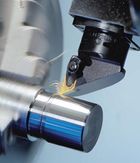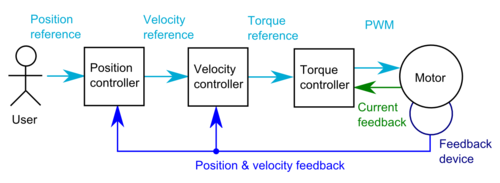Difference between revisions of "Control modes"
| [checked revision] | [checked revision] |
(→Torque control) |
|||
| Line 2: | Line 2: | ||
==Torque control== | ==Torque control== | ||
[[File:Force-torque-wrench.jpg|thumb|140px|Torque]] | [[File:Force-torque-wrench.jpg|thumb|140px|Torque]] | ||
| − | Torque control mode makes motor a torque or force transducer. I.e. user sets torque | + | Torque control mode makes motor a torque or force transducer. I.e. user sets torque setpoint to 1 Nm, then motor will produce 1 Nm torque regardless of spinning speed. In torque mode user can not set limits to velocity or position. |
;Typical applications | ;Typical applications | ||
| Line 12: | Line 12: | ||
==Velocity control== | ==Velocity control== | ||
[[File:Turning.jpg|thumb|140px|Velocity]] | [[File:Turning.jpg|thumb|140px|Velocity]] | ||
| − | Goal of velocity control is to regulate motor speed. I.e. if user velocity | + | Goal of velocity control is to regulate motor speed. I.e. if user velocity setpoint is 500 rpm, then motor attempts to rotate exactly at 500 rpm no matter how much load is attached to motor. In velocity mode user can set limits for torque but not for position. |
;Typical applications | ;Typical applications | ||
| Line 23: | Line 23: | ||
==Position control== | ==Position control== | ||
[[File:CartesianRobot.gif|thumb|140px|Position]] | [[File:CartesianRobot.gif|thumb|140px|Position]] | ||
| − | Position control mode attempts to provide precision positioning. Motor follows | + | Position control mode attempts to provide precision positioning. Motor follows setpoint set point and if set point is kept constant, motor holds position even if external forces attempt to displace it. In position mode user can set limits to torque and velocity. |
;Typical applications | ;Typical applications | ||
| Line 36: | Line 36: | ||
==Controller structure== | ==Controller structure== | ||
[[File:Cascade position controller.png|thumb|500px|Simplified VSD drive block diagram in position mode. Limiters are not pictured. ]] | [[File:Cascade position controller.png|thumb|500px|Simplified VSD drive block diagram in position mode. Limiters are not pictured. ]] | ||
| − | VSD drives use cascaded controllers. So for example in velocity mode, torque controller and velocity contoller are connected in series so that torque | + | VSD drives use cascaded controllers. So for example in velocity mode, torque controller and velocity contoller are connected in series so that torque setpoint is generated by velocity controller. Position mode is same as velocity controller except the velocity setpoint is generated by position controller. |
Cascaded structure leads to more flexible features and enables higher dymamic performance compared to direct PWM or torque control from position controller. | Cascaded structure leads to more flexible features and enables higher dymamic performance compared to direct PWM or torque control from position controller. | ||
| Line 43: | Line 43: | ||
:User torque rererence → Torque limiter → Torque controller outputs motor PWM | :User torque rererence → Torque limiter → Torque controller outputs motor PWM | ||
;Velocity controller stucture | ;Velocity controller stucture | ||
| − | :User velocity | + | :User velocity setpoint → Velocity limiter → Velocity controller outputs torque rererence → Torque limiter → Torque controller outputs motor PWM |
;Position controller stucture | ;Position controller stucture | ||
| − | :User position | + | :User position setpoint → Position controller outputs velocity setpoint → Velocity limiter → Velocity controller outputs torque rererence → Torque limiter → Torque controller outputs motor PWM |
| − | Limiters simply cut and saturate | + | Limiters simply cut and saturate setpoint signal if user specified torque/velocity limit is exceeded. |
Revision as of 21:25, 24 June 2013
There are three main control modes in motion & motor control are torque, velocity and position control.
Torque control
Torque control mode makes motor a torque or force transducer. I.e. user sets torque setpoint to 1 Nm, then motor will produce 1 Nm torque regardless of spinning speed. In torque mode user can not set limits to velocity or position.
- Typical applications
- Feeding/pulling/winding
- Racing/flight simulators
- Final stage in velocity or position controller
- Non-motion applications: high power adjustable current source
Velocity control
Goal of velocity control is to regulate motor speed. I.e. if user velocity setpoint is 500 rpm, then motor attempts to rotate exactly at 500 rpm no matter how much load is attached to motor. In velocity mode user can set limits for torque but not for position.
- Typical applications
- Spindles
- Feeding
- Fans & pumps
- Screw tightening robot when used with torque limit
- Intermediate stage in position control
Position control
Position control mode attempts to provide precision positioning. Motor follows setpoint set point and if set point is kept constant, motor holds position even if external forces attempt to displace it. In position mode user can set limits to torque and velocity.
- Typical applications
- CNC
- Pick & place machines
- 2D/3D printing
- Robotics
- Welding
Controller structure
VSD drives use cascaded controllers. So for example in velocity mode, torque controller and velocity contoller are connected in series so that torque setpoint is generated by velocity controller. Position mode is same as velocity controller except the velocity setpoint is generated by position controller.
Cascaded structure leads to more flexible features and enables higher dymamic performance compared to direct PWM or torque control from position controller.
- Torque controller stucture
- User torque rererence → Torque limiter → Torque controller outputs motor PWM
- Velocity controller stucture
- User velocity setpoint → Velocity limiter → Velocity controller outputs torque rererence → Torque limiter → Torque controller outputs motor PWM
- Position controller stucture
- User position setpoint → Position controller outputs velocity setpoint → Velocity limiter → Velocity controller outputs torque rererence → Torque limiter → Torque controller outputs motor PWM
Limiters simply cut and saturate setpoint signal if user specified torque/velocity limit is exceeded.



